Gerbera Daisy, Transvaal Daisy, Barberton Daisy, Gerber Daisy
Gerbera jamesonii, commonly known as the Gerbera Daisy or Transvaal Daisy, is one of the most popular ornamental flowers in the world, both as cut flower and pot plant. Originating from South Africa, this perennial flower is cherished for its large, daisy-like flowers that bring a splash of color to any setting for months. Gerbera daisy is a staple in the cut flower industry due to its long vase life and wide array of colors.
Gerbera jamesonii is characterized by its bright, bold flowers, which come in a plethora of colors, including yellow, orange, white, pink, and red. The flowers are held on long, slender stems that rise above a rosette of dark green, lobed leaves. Each flower consists of a central disc surrounded by numerous ray petals, creating a striking appearance.
Native: This plant is native to South Eastern Africa, where it thrives in open, sandy, and well-drained soils. Gerbera Daisies belong to the aster family, Asteraceae, along with daisies and sunflowers.
Plant Type and Habit: Gerbera daisy is an elegant, upright, evergreen perennial, often grown as an annual, that forms a basal rosette of leaves. It has a clump-forming habit, producing solitary flower stems that do not branch.
Size: The plant typically grows up to 24 inches (60 cm) and spreads to 18 inches (45 cm), forming a dense clump of foliage and flowers.
Flowers: Gerbera daisies are renowned for their large, colorful, single, or semi-double daisy-like flowers, measuring up to 5 inches (12 cm) across. They are perfect for cutting and have a long vase life (around 7 to 14 days), making them favorites in floral arrangements. Gerbera daisies bloom any time of the year (as perennial), with peaks in early summer and late fall.
Foliage: The foliage consists of tongue-shaped, dark green, lobed leaves that form a rosette at the base of the plant. The leaves can be up to 10 inches (25 cm) long and provide a lush, green backdrop for the colorful flowers.
Hardiness: This perennial flower is hardy in USDA zones 8-11. It can be grown as an annual or overwintered indoors in cooler climates.
Uses: Gerbera daisies are widely used as ornamental plants in gardens, pots, and as cut flowers. They are also popular in wedding bouquets and arrangements due to their varied colors and forms.
Wildlife: Gerbera daisies can attract bees and butterflies to the garden.
Deer and Rabbits: Gerbera daisies are somewhat resistant to deer, but rabbits will eat them.
Drought Tolerance: Gerbera daisies prefer regular watering but are somewhat drought-tolerant once established. However, prolonged drought can affect flowering and overall health.
Toxicity: Gerbera daisies are not considered toxic to humans or pets, making them a safe choice for households.
Invasiveness: Gerbera jamesonii is not considered invasive in its native range or in most areas where it is cultivated.
Benefits: Beyond their aesthetic appeal, Gerbera daisies can help purify the air. NASA studies have shown that they effectively remove certain toxins from indoor environments.
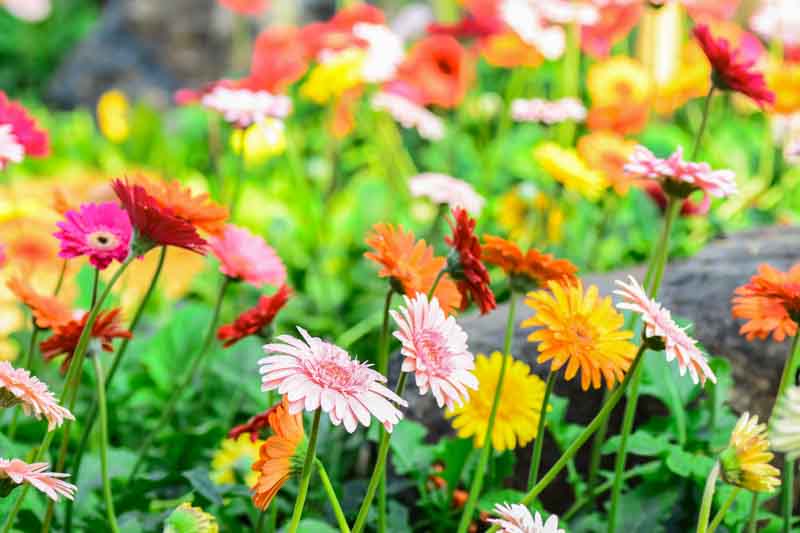
In cooler climates (USDA zones below 8): Plant Gerbera Daisies in spring after the last frost when the soil has warmed up. This ensures cold temperatures won’t damage them.
In warmer climates (USDA zones 8 and above): They can be planted in the fall or early spring, allowing them to establish before the intense summer heat or in preparation for their winter growth period.
Sunlight: Choose a location that receives full sun for at least 6 hours a day. Gerbera Daisies thrive in bright light, which encourages maximum blooming. However, afternoon shade is appreciated in hot summer climates.
Soil: Ensure the planting site has organically rich, well-drained soil. These plants do not like to sit in waterlogged soil, as it can lead to root rot. Consider raising the bed or planting in containers with drainage holes if drainage is a concern.
Soil Preparation: Work the soil to a depth of 8-10 inches (20-25 cm), incorporating organic matter like compost to improve drainage and fertility.
Planting: When planting Gerbera Daisies, be careful not to bury them too deep. The crown of the plant (where the stem meets the roots) should be slightly above the soil level to prevent rot. Space plants about 12-18 inches apart (30-45 cm) to allow for air circulation and growth.
Watering: After planting, water thoroughly. Establish a regular watering routine that keeps the soil moist but not soggy. Allow the top inch of soil to dry out between waterings.
Mulching: Apply a thin layer of mulch around the plants to help retain moisture, regulate soil temperature, and reduce weed competition. Avoid piling mulch against the plant stems to prevent moisture buildup and potential rot.
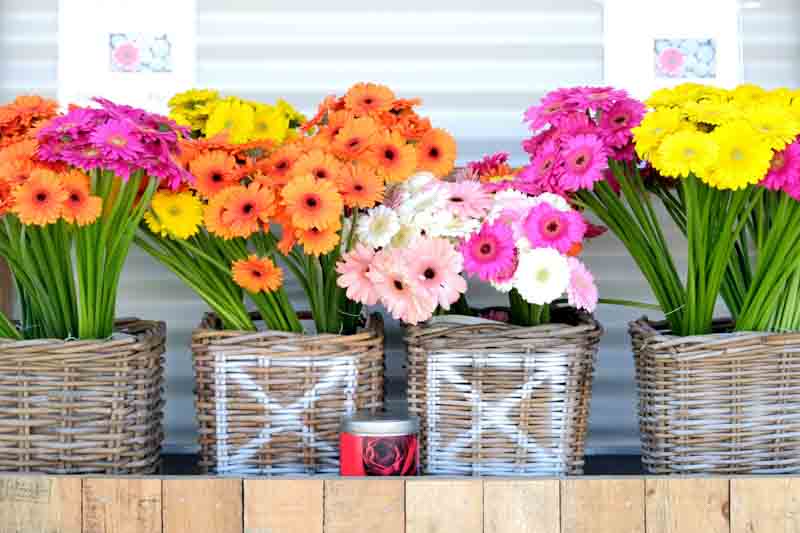
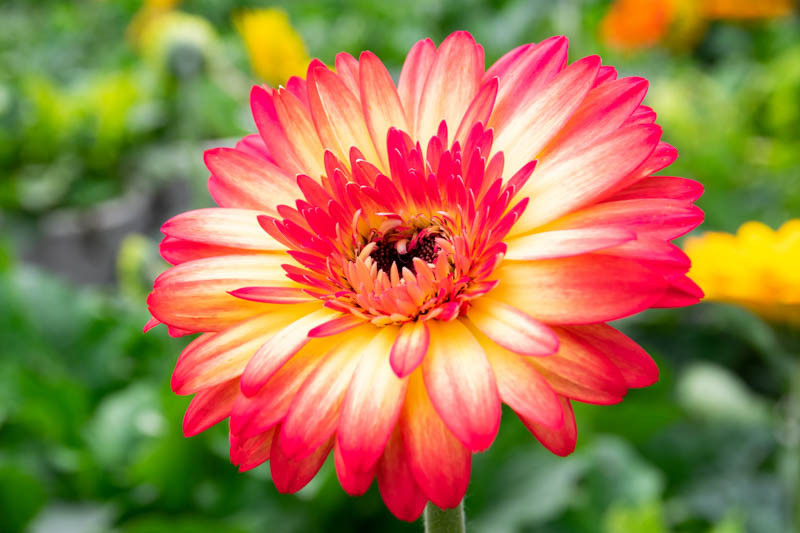
Potting and repotting Gerbera Daisies are key to their health and blooming success. Use a well-draining potting mix and a pot with drainage holes to prevent waterlogging. When repotting, choose a pot only slightly larger than the current one to avoid excess soil moisture. Gently loosen the root ball and place the plant at the same depth it was previously. Ensure you keep the root crown slightly above the soil level. Water thoroughly after repotting. Position the pot in a spot with ample sunlight. Repot every 1-2 years or when roots become crowded.
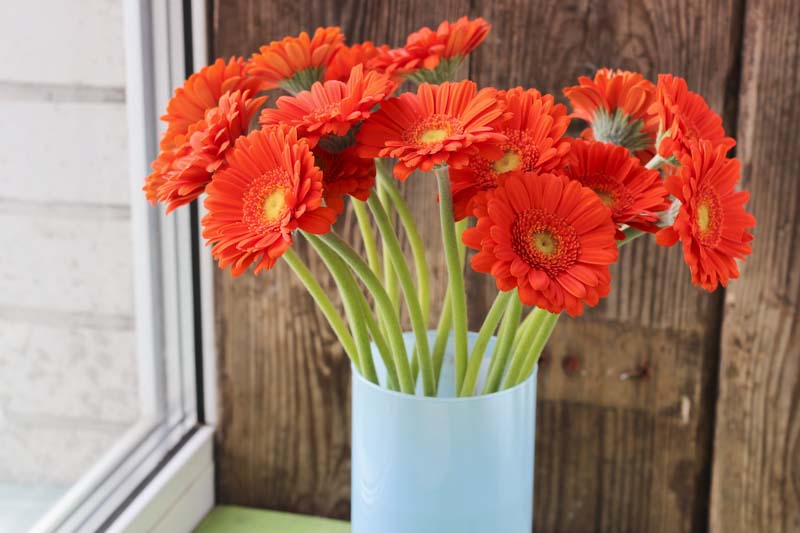
Choose the Right Time: Harvest Gerbera daisies in the cool of the morning after the dew has dried or in the late afternoon. Look for blooms that are fully open or just about to open.
Use Clean, Sharp Tools: Cut the stems with a clean, sharp pair of scissors or pruning shears. This prevents damage to the plant and reduces the risk of disease.
Cut at an Angle: Cut at a 45-degree angle about 1 inch from the base of the stem. This increases the surface area for water uptake.
The vase life of Gerbera daisies, when properly cared for, is typically around 7 to 14 days. This duration can be extended with the right care
Clean Vase: Use a clean vase to prevent bacterial growth. Wash it with soap and water before use.
Prepare Water: Fill the vase with lukewarm water. Warm water travels up the stem more efficiently than cold water. The stems of gerbera daisies can weaken and decay in deep water. Maintaining a shallow water level in the vase helps prevent this, ensuring the stems remain strong and the flowers are vibrant for longer.
Add Flower Food: Mix commercial flower food into the water according to package instructions. This gives the flowers essential nutrients and includes a biocide to keep the water clean.
Remove Lower Leaves: Strip any leaves from the stem that would sit below the water line. Leaves in the water can rot, creating bacteria that shorten the life of the flowers.
Place in the Right Spot: Keep the vase away from direct sunlight, drafts, and ripening fruit, which emits ethylene gas that can cause flowers to age prematurely.
Change Water Regularly: Replace the water every 2-3 days or if it becomes cloudy. Clean the vase and recut the stems at an angle each time to ensure optimal water uptake.
Trim Stems: Trimming about an inch off the stems during each water change can help extend the flowers’ vase life by ensuring the stems can absorb water efficiently.
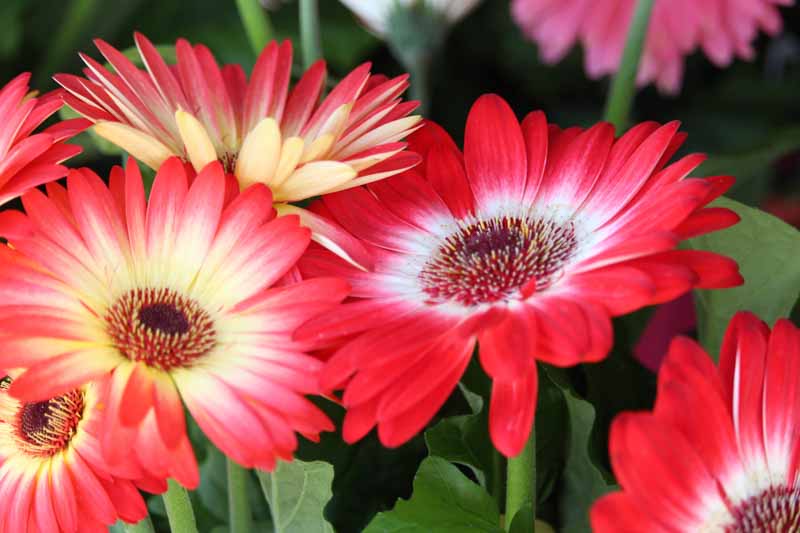
Gerbera Daisies are stunning flowers that can brighten up any garden space, but like all plants, they are susceptible to certain pests and diseases.
When Gerbera daisies experience problems such as not blooming, wilting, or yellowing leaves, it can be due to a variety of issues. Understanding and addressing the underlying cause is key to restoring plant health. Here are some potential reasons and their symptoms:
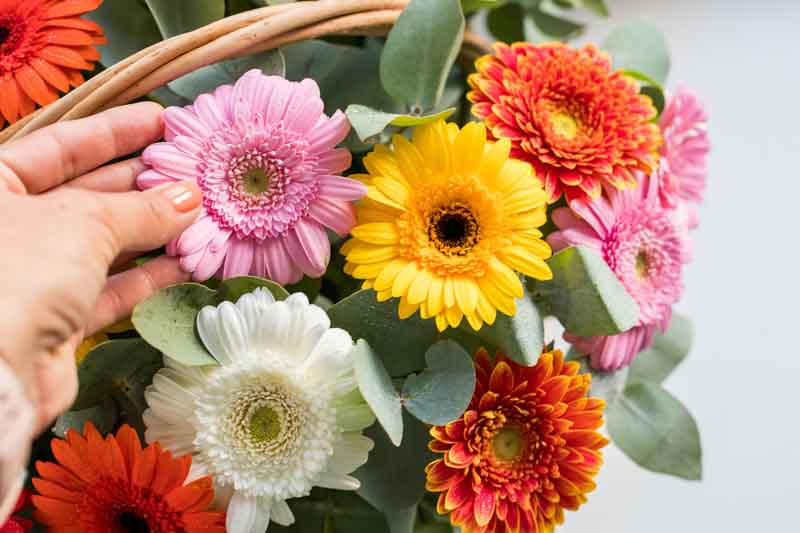
Gerbera Daisies (Gerbera jamesonii) are perennials in USDA hardiness zones 8-11, where they can survive winter conditions and bloom each year. They are often grown as annuals in cooler zones or can be brought indoors to overwinter.
Gerbera Daisies are non-toxic to cats, dogs, and horses. According to the ASPCA, they are considered one of the safe plants to have around pets.
To keep Gerbera Daisies blooming, ensure they receive adequate sunlight, water, and nutrients. Deadhead spent flowers to encourage new blooms.
In the right conditions (zones 8-11), they can come back every year. In cooler zones, they can be grown as annuals or overwintered indoors to bloom again.
Gerbera Daisies can thrive both in pots and in the ground, provided they have well-drained soil and adequate sunlight. Pots offer better drainage control and the flexibility to move plants to optimal locations or indoors during harsh weather.
Gerbera Daisies perform best in full sun to partial shade. They require at least 6 hours of direct sunlight daily to bloom profusely. While they can tolerate some shade, too little sunlight may reduce blooming and weaken the plant.
| Hardiness |
8 - 11 |
|---|---|
| Heat Zones |
6 - 11 |
| Climate Zones | 8, 9, 12, 13, 14, 15, 16, 17, 18, 19, 20, 21, 22, 23, 24, H1, H2 |
| Plant Type | Annuals, Perennials |
| Plant Family | Compositae |
| Genus | Gerbera |
| Common names | Gerbera Daisy |
| Exposure | Full Sun, Partial Sun |
| Season of Interest |
Spring (Early, Mid, Late) Summer (Early, Mid, Late) Fall Winter |
| Height |
1' - 2' (30cm - 60cm) |
| Spread |
1' - 2' (30cm - 60cm) |
| Spacing | 24" (60cm) |
| Maintenance | Low |
| Water Needs | Average |
| Soil Type | Chalk, Loam, Sand |
| Soil pH | Acid, Alkaline, Neutral |
| Soil Drainage | Well-Drained |
| Characteristics | Cut Flowers, Showy, Evergreen |
| Attracts | Bees, Butterflies |
| Garden Uses | Beds And Borders, Patio And Containers, Wall-Side Borders |
| Garden Styles | City and Courtyard, Coastal Garden, Cutting Garden, Informal and Cottage, Mediterranean Garden |
| Hardiness |
8 - 11 |
|---|---|
| Heat Zones |
6 - 11 |
| Climate Zones | 8, 9, 12, 13, 14, 15, 16, 17, 18, 19, 20, 21, 22, 23, 24, H1, H2 |
| Plant Type | Annuals, Perennials |
| Plant Family | Compositae |
| Genus | Gerbera |
| Common names | Gerbera Daisy |
| Exposure | Full Sun, Partial Sun |
| Season of Interest |
Spring (Early, Mid, Late) Summer (Early, Mid, Late) Fall Winter |
| Height |
1' - 2' (30cm - 60cm) |
| Spread |
1' - 2' (30cm - 60cm) |
| Spacing | 24" (60cm) |
| Maintenance | Low |
| Water Needs | Average |
| Soil Type | Chalk, Loam, Sand |
| Soil pH | Acid, Alkaline, Neutral |
| Soil Drainage | Well-Drained |
| Characteristics | Cut Flowers, Showy, Evergreen |
| Attracts | Bees, Butterflies |
| Garden Uses | Beds And Borders, Patio And Containers, Wall-Side Borders |
| Garden Styles | City and Courtyard, Coastal Garden, Cutting Garden, Informal and Cottage, Mediterranean Garden |
How many Gerbera jamesonii (Gerbera Daisy) do I need for my garden?
| Plant | Quantity | |
|---|---|---|
| Gerbera jamesonii (Gerbera Daisy) | N/A | Buy Plants |
Create a membership account to save your garden designs and to view them on any device.
Becoming a contributing member of Gardenia is easy and can be done in just a few minutes. If you provide us with your name, email address and the payment of a modest $25 annual membership fee, you will become a full member, enabling you to design and save up to 25 of your garden design ideas.
Join now and start creating your dream garden!
Create a membership account to save your garden designs and to view them on any device.
Becoming a contributing member of Gardenia is easy and can be done in just a few minutes. If you provide us with your name, email address and the payment of a modest $25 annual membership fee, you will become a full member, enabling you to design and save up to 25 of your garden design ideas.
Join now and start creating your dream garden!